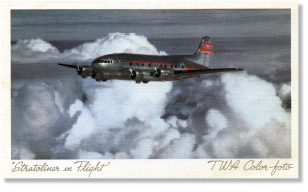
By MICHAEL BUSHNELL
Northeast News
January 16, 2013
To be repeated in your best airport announcer voice, with feeling and inflection: “Teeee Double UUU AAAY announces the departure of the Super Sky-Chief Strato-liner for Kansas City, Albuquerque and Los Angeles. Gate three, all aboard please! Day and night these mighty ships of commerce fly the air-lanes from Atlantic to Pacific!”
Wow! Back when air travel was Air Travel, not schleppin’ in a pair of cargo shorts and flip flops for a quick flight to Miami. Back in 1935, Boeing engineers developed a passenger plane based on the format of the successful B-17 heavy bomber platform, and the Boeing 307 Stratoliner was born. It was the first airliner to feature a pressurized cabin, truly a cutting edge development in the new mode of air travel. Prior to cabin pressurization, passenger aircraft such as the Douglas DC-3 were limited to altitudes under 12,000 or 14,000 feet.
In 1937, Pan American Airways ordered two of the planes, then almost immediately bumped the order to six. Transcontinental & Western Air, the forerunner to TWA, ordered another five of the shiny new planes and Boeing began an initial run of production. The Model 307 had capacity for a crew of five and 33 passengers, including a pullman area for transcontinental flights that often took 15 hours. World War II, however, intervened and all of TWA’’s 307’s were pressed in to military service as C-75’s and operated under a contract with the Army’’s Air Transport Command until July of 1944.
The Stratoliner was the only plane capable of crossing the Atlantic Ocean until the introduction of the Douglas C-54 Skymaster in November of 1942. After 1944, when the planes were returned to TWA, Boeing upgraded the wing and tail area to match that of the B-17G and upgraded the four 900 hp engines to the newer Wright Cyclone, 1200 hp motors. Electrics were also upgraded to match that of the new B-29 Super Fortress. Following the war, most of the planes were sold to foreign airlines as the jet engine soon replaced the old prop driven planes quickly for American airline service. To date, there is only one remaining sky-worthy Boeing 307, and it is on display at the Smithsonian Air and Space Museum in Washington, D.C.

















